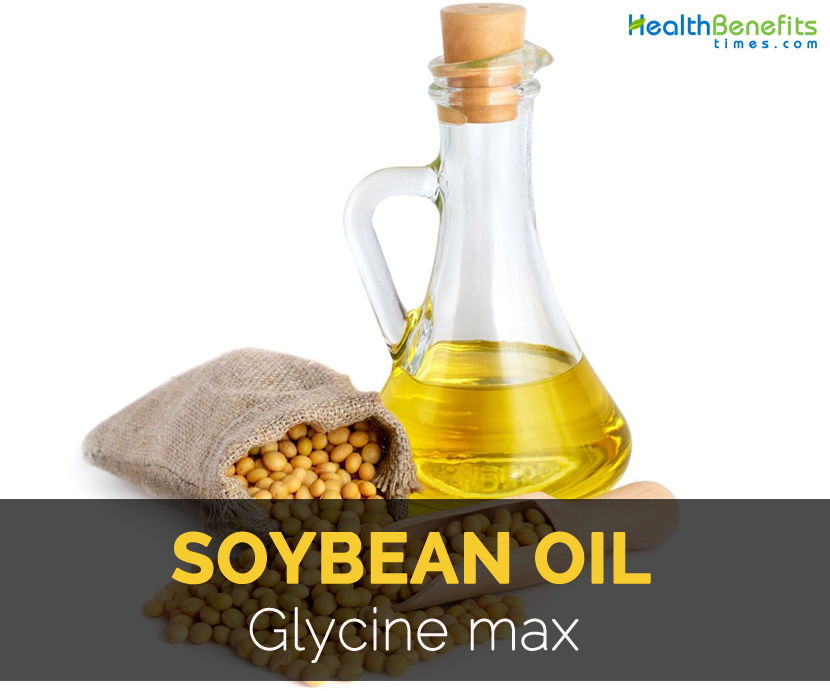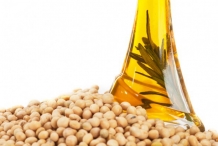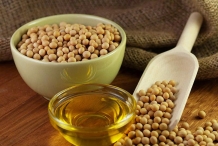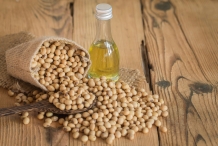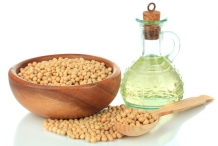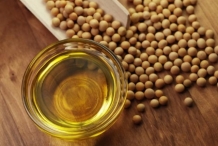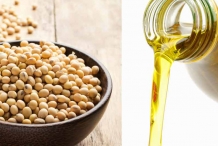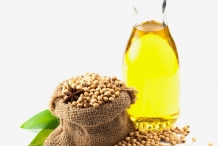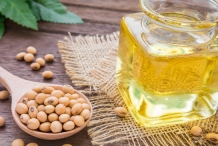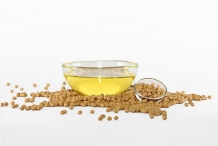History
Soybean is native to East Asia. Soybean was traced in 11th BC from eastern half of North China. The production of soybean was localized after China to Japan war of 1894 to 1895 in China. The shipments of soybean were made to Europe in 1908. The word soybean was firstly used in 1804. Recently, the annual consumption of edible oils is more than 28 billion pounds of American. Korea and Mexico are considered to be the highest consumers of US.
Nutritional value
Soybean oil has high content of leucine, threonine, isoleucine, tryptophan, glutamic acid and aspartic acid. It also contains Vitamin K, A, E and C. The minerals such as copper, calcium, magnesium, manganese, selenium, zinc, phosphorus and iron are also found in it.
Health benefits of Soyabean oil
Soyabean oil is derived from soybean seeds. It is scientifically known as Glycine max. It has vitamins such as Vitamin E, Vitamin K, Vitamin B and choline. This oil has antioxidant properties that protects the bodily cells and prevent heart diseases. It assists the functions of nervous system. Vitamin K regulates the blood calcium level and formation of bones. It is essential for blood clotting.
- Level of cholesterol
Soybean oil has healthy fatty acids that regulate the level of cholesterol. The presence of Omega-3 fatty acids that helps to lower the level of cholesterol. Soybean oil has sterols such as β-sitosterol that helps to lower cholesterol in gut by 10 to 15%. It lowers the chances of atherosclerosis and heart problems such as strokes and heart attacks. (1) (2)
- Treat Alzheimer’s disease
Alzheimer’s disease lowers the cognition of brain because the neural connection dies. It has impressive amounts of Vitamin K that helps improves Alzheimer’s disease. The antioxidant properties help to promote free radicals that prevent the damage of neural cells. (3)
- Bone health
Vitamin K helps to enhance regrowth and healing of bones. It helps to prevent the conditions such as osteoporosis that is related to aging. (4)
- Skin and eye health
It has omega-3 fatty acids about 7% that helps to protect cardiovascular health by eliminating bad cholesterol. It acts as antioxidants that help to neutralize free radicals which cause cataracts and macular degeneration. (5)
- Antioxidant activity
Soyabean oil has antioxidant activity that prevents free radical damage. It reduces acne scarring, appearance of blemishes, protects from sunburn, lowers acne scarring and stimulates regrowth of new cells. It eliminates free radicals that could cause skin conditions such as premature aging, cancer, heart diseases and cognitive ailments. (6)
Traditional uses
- It prevents damage caused by free radicals that is associated with heart problems, cancers, premature aging, cataracts and arthritis.
- It helps to lower bad cholesterols and also treat osteoarthritis.
- Apply soybean oil to the skin directly that helps to repel mosquitoes and other insects.
- It prevents cholesterol absorption.
- It slows down aging process and prevents skin problems.
- It assists in formation and strengthening of bones.
- It also prevents damage of brain cells.
- It lowers the chances of arrhythmia and cardiovascular ailments.
Culinary uses
- It is used in crackers, breads, non-dairy creamers and barbecue sauce.
- It is also used for potato chips, whipped toppings, breaded snacks and vegetables.
- It is used for salad dressing, mayonnaise, margarine and non-dairy coffee creamers.
- Due to its high smoke point, it is used for frying and baking purposes.
Precautions
- It has calories.
- The people who are allergic to peanuts should avoid it.
- Allergic reactions such as hypersensitivity, hives, urticarial and eczematous dermatitis might be experienced.
- Severe cases symptoms are gastritis, vomiting, swelling of lips, pain abdomen, breathing difficulty, chest congestion, wheezing and some cases lead to death.
Other Facts
It is also used for inks, bio diesel, crayons, plasticizers, soy candles and paints.
Soyabean oil facts
Soybean oil is a vegetable oil that is used as a healthy food ingredient despite having bad publicity of oils and fats. It is well known due to its healthful, cheap and high smoking point. It does not have high content of saturated fat and no cholesterol. The oil has antioxidants that prevent oxidative rancidity. This oil is highly used for cooking, to make margarines and for the production of soaps and cosmetics as well as biofuel.
| Soybean oil Quick Facts | |
|---|---|
| Name: | Soybean oil |
| Scientific Name: | Glycine max |
| Origin | Soybean is native to East Asia. Soybean was traced in 11th BC from eastern half of North China. |
| Colors | Dark yellow, faint green |
| Taste | Neutral |
| Health benefits | Level of cholesterol, Treat Alzheimer's disease, Bone health, Skin and eye health, Antioxidant activity |
| Name | Soybean oil |
|---|---|
| Scientific Name of Soybean | Glycine max |
| Native | Soybean is native to East Asia. Soybean was traced in 11th BC from eastern half of North China. The production of soybean was localized after China to Japan war of 1894 to 1895 in China. |
| Common/English Name of Soybean | Aceite de Soja, Glycine gracilis, Dolichos soja, Glycine hispida, Glycine soja, Glycine max, Huile de Germes de Soya, Huile de Germes de Soja, Huile de Soja, Intralipid, Huile de Soya, Intralipide, Legume, Phaseolus max, Légumineuse, Soja hispida, Soy Bean Oil, Soja max, Soy Oil, Soyca, Soya Oil, Travmulsion |
| Name in Other Languages of Soybean | Chinese: Dòu (豆), Wū dòu (乌豆), Dàdòu (大豆), Xiá yè bái huāyě dàdòu (狭叶白花野大豆), Bái huāyě dàdòu (白花野大豆), Xì jīng dàdòu (细茎大豆), Shū (菽), Yě dàdòu (野大豆), Yě huángdòu (野黄豆), Huángdòu (黄豆); Dutch: Sojaboon; Finnish: soijapapu; French: Soja; German: Sojabohne; Hindi: bhat (भाट), bhatwar (भाटवार); Japanese: daizu (ダイズ); Korean: kong; Russian: Soja; Spanish: frijol de soya, Glycine max, Soya; Swedish: sojaböna; Vietnamese: dâu nành, dâu tuog; |
| Major nutritions | Total Fat (lipid) 218 g (622.86%) Vitamin K (phylloquinone) 400.9 µg (334.08%) Vitamin E (alpha-tocopherol)17.83 mg (118.87%) Iron, Fe 0.11 mg (1.38%) Zinc, Zn 0.02 mg (0.18%) |
References:
http://articles.mercola.com/herbal-oils/soy-bean-oil.aspx
https://www.organicfacts.net/health-benefits/oils/soybean-oil.html
http://www.nutrition-and-you.com/soybean-oil.html
http://www.soya.be/soybean-oil.php


